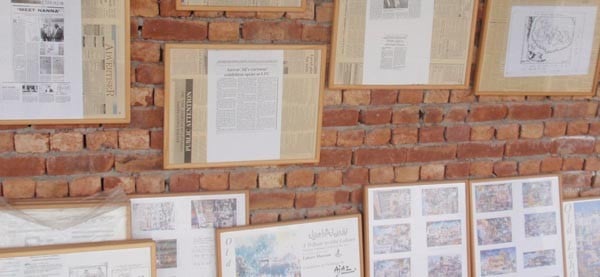

Distinguished conservationist and watercolour artist Dr Ajaz Anwar these days likes to spend most of his time at 62-Chinar Courts, Raiwind Rd, a suburb, in the House of Nanna, a trust organisation he has set up to promote art and culture.
A piece of simple architecture, this 4-kanal house, which is still under construction, is Ajaz’s tribute to his late father, the great cartoonist Anwar Ali aka Nanna. It boasts, aside from other things, an exhibition hall where new artists can showcase their works and a small institute where students can learn the art of making sketches and cartoons.
"The purpose of the trust is to create an environment and an opportunity for students and younger generations to appreciate the great works of their elders and also to display their own creations," Ajaz Anwar says.
Further plans include setting up a museum where archives of political and socially relevant cartoons by Nanna will be placed for public viewing. These cartoons and sketches were published in leading dailies, mainly Pakistan Times, in Nanna’s lifetime.
Anwar reveals he has collected, in his home library, at least "600 sketches" of the late artist.
Self-taught artist, Anwar Ali Nanna (1922-2004) used to draw sketches while he was in college in Ludhiana. He never attended an arts institute or academy. As he grew up, he started contributing to the daily Dawn, published from New Delhi at the time. Later, he was appointed staff cartoonist at Pakistan Times, Lahore, in early 1947. This was where he created the immortal character of "Nanna" who would hold up a mirror to the society’s ills. Unfortunately, he was always considered but never given any civil award of the country, perhaps due to the political nature of his work.
Nanna also worked, albeit briefly, at Viewpoint. He would contribute short stories in English, occasionally illustrated with sketches and photographs. These stories are also up for reprinting by the House of Nanna.
Nanna’s assorted works also include short stories in Punjabi which were published in three collocations titled ‘Guaachian Gallan’ (forgotten memos), ‘Noori’ and ‘Kaalian Ittan Kale Roarre,’ based on folklore.
"At the Government College [in Ludhiana], my father would pin up his cartoons at the notice board, anonymously," Ajaz Anwar recounts. "Once he made a sketch of his British principal and ran off after putting it up on the college notice board because he was scared of the repercussions. Interestingly, when his principal found the sketch, he called on him and not only praised him for his artistic faculties but also gave him a small prize to encourage him to continue in his hobby."
When he entered the practical field -- he took up a clerical job in a government department -- Nanna continued to make cartoons anonymously on purpose. He would travel all the way from Ludhiana to Delhi to submit his cartoons for publication in Dawn in the 1940s.
Nanna was also a big promoter of one’s mother tongue. His fictional character "Nanna" (‘the little one’ in Urdu) was so popular that it became part of his own name.
According to Ajaz Anwar, "The purpose of the setting up the institute is also to project the soft image of Pakistan. We want to show to the world that this land has produced some great work in art which also critically looks at our society at large.
"Such art must be preserved and extended to the future generations," add the painter who has recreated the old Lahore in watercolours. "There are plans to hold seminars and discussions in order to create awareness about rights and to promote watercolour artwork."
Ajaz Anwar admits that the fee is a tad too high but those who cannot afford it have the option of enlisting as a member.
About the tradition of cartoon strips, noted professor of Journalism Dr Mehdi Hasan says, "Sadly, it could not thrive as much as it should have. Cartoons and illustrations are a great way of knowing history and the ups and downs a society or a nation has lived through. Today, you rarely come across cartoons of the calibre of Nanna."
Ajaz Anwar intends to publish a book comprising all of Nanna’s sketches. Collecting them has been no mean feat for him. He admits that he has had to dig the record rooms of newspapers, different libraries and private collections.
Some enlarged copies of Nanna’s works are already on display in the House. They present the social and political history of the country spanning well over a period of 40 years. One of them shows the lynching of a journalist who was detained during the time of Gen Zia-ul-Haq. The inscription below the sketch reads, "It was not published by any newspaper at that time".
Hussain Naqi, former Lahore editor of The News and currently working with a leading human rights organisation of Pakistan, says, "His work tells the history of Pakistan.
"Nanna’s message was subtle and poignant. Through his political and social satires he highlighted the aspirations and the frustrations of the common people. Today, there are only a few cartoonists who represent the same tradition. These include Maxim, Zahoor, Khalid Hussnain and Sabir Nazar. There is a need to do more."
Gradually, the House of Nanna, as it is called, is becoming a source of attraction for the students of arts in the nearby universities.